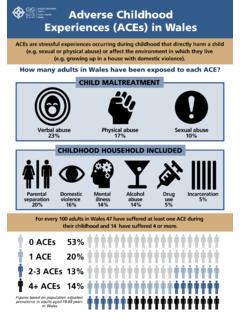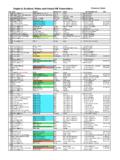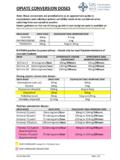Transcription of Guidance for Family Resilience Assessment Instrument and ...
1 Family Resilience Assessment Instrument and Tool (FRAIT) Guidance Guidance for Family Resilience Assessment Instrument and Tool (FRAIT). This is what the Family Resilience Assessment Tool looks like. It is 3 sides of A4. This is what the Family Resilience Assessment Instrument looks like. It is 1 side of A4. Copyright 2017 University of South wales , Abertawe Bro Morgannwg University Health Board, Hywel Dda University Health Board. This document was authored by Carolyn Wallace, Fran Dale, Georgina Jones, Jane O'Kane, Michelle Thomas, Liz Wilson, David Pontin. FRAIT Guidance - What is the FRAIT for? To help Health Visitors (HVs) make robust, consistent and reliable assessments of Family Resilience . HVs from across wales have helped develop and test the FRAIT. Family Resilience Assessment Tool (FRAT) is for HVs to use the in their everyday practice to assess the Resilience of families on their caseloads, and to help identify the support and interventions needed to help families deal with adversity.
2 HVs will use FRAT as part of their scheduled work with families outlined in the Healthy Child wales (HCW) programme, and when they meet families for the first time who have moved into the area and joined theircaseload. Family Resilience Assessment Instrument (FRAI) is designed for assessing/scoring Family Resilience as perceived by the HV. It is made up of red flags' issues identified by HVs in wales as important for assessing Resilience . It may be used for different purposes - part of workload acuity calculation, and for briefing colleagues from other services about a Family 's situation. What is Family Resilience ? Family Resilience refers to the qualities families need to successfully cope with stressful periods and crisis situations (McCubbin and McCubbin 1988). The concept of Family Resilience helps us to understand why some families survive stress and adversity, and why some families then go on to thrive and become stronger as a result (Black and Lobo 2008). How does using Family Resilience fit with HV practice?
3 HVs support families and make interventions influenced by the strength of Family Resilience . A. central part of the HV role is the early identification of problems, and providing preventative support to promote Family well-being (WAG 2011). Using evidence-informed materials to measure Family Resilience (Lee et al 2003) will help HVs provide support for families and promote protective factors so families can deal with adversity. This maximises the likelihood of robust, replicable identification of need. NHS wales aims to have an all- wales approach to identifying Family need based on consistent and reliable assessments, prudent use of health resources, and measurable health outcomes. This will help to improve the state of the nation's health in the short and long term (WAG. 2011). Copyright 2017 University of South wales , Abertawe Bro Morgannwg University Health Board, Hywel Dda University Health Board. This document was authored by Carolyn Wallace, Fran Dale, Georgina Jones, Jane O'Kane, Michelle Thomas, Liz Wilson, David Pontin.
4 2 of 11. FRAIT Guidance - Using the Family Resilience Assessment Tool (FRAT). HVs will use the FRAT in their everyday practice to assess a Family 's Resilience , and to identify the support and interventions needed to help them deal with adversity. HVs will use FRAT as part of their scheduled work with families (Healthy Child wales Programme), or when they meet a Family for the first time if they move into the area and join their caseload. FRAT has 36 items expressed as statements. HVs record their level of concern about each statement - low, low/medium, medium, medium/high, high. The items are grouped into 4 sections: Section A- Main Parent/Carer's health and well-being Section B- Supporting Parent/Carer's Health and well-being NB: If there is more than one child in the Family with involvement from different Supporting Parents/Carers you will need to complete additional copies of Section B. Section C- External influences/environmental factors Section D- Child's health and well-being NB: A different Section D will need to be completed for each child in the Family receiving HV input Please use all 4 sections when you use the FRAT to make an Assessment .
5 It is important that you use all your observation skills and knowledge of the Family when making the Assessment of Family Resilience . We don't recommend that you complete it in the home. When you are making your Assessment of the Family 's situation please take into account any protective factors, negative factors, and vulnerability. Identify any concerns you may have by shading in the relevant area of the grid(see illustration below). If you do not have the relevant information to make a judgement about the item then leave it blank. You can come back to the FRAT when you have the information and will be able to review Copyright 2017 University of South wales , Abertawe Bro Morgannwg University Health Board, Hywel Dda University Health Board. This document was authored by Carolyn Wallace, Fran Dale, Georgina Jones, Jane O'Kane, Michelle Thomas, Liz Wilson, David Pontin. 3 of 11. FRAIT Guidance - your Assessment . When you have shaded the items in all sections you can then see the areas where the Family may require support and/or interventions to help them build their Resilience .
6 Completing the FRAT forms The front page of the FRAT records details of Family members who are the focus of Assessment . Include the date of Assessment for each section. In sections A & B - record the name of the adult being assessed and their relation to the child or children. If there is more than one child in the Family with involvement from different Supporting Parents/Carers you will need to complete additional copies of Section B. Recording educational level allows us to link Family Resilience to Family demographics. We're using the UK Census 2011. categories (see details below). Educational qualification levels: UK Census 2011. No qualifications Level 1: 1-4 O Levels/CSE/GCSEs (any grades), Entry Level, Foundation Diploma, NVQ Level 1, Foundation GNVQ, Basic/Essential Skills Level 2: 5+ O Level (Passes)/CSEs (Grade 1)/GCSEs (Grades A*-C), School Certificate, 1 A Level/ 2-3 AS. Levels/VCEs, Intermediate/Higher Diploma, Welsh Baccalaureate Intermediate Diploma, NVQ level 2, Intermediate GNVQ, City and Guilds Craft, BTEC First/General Diploma, RSA Diploma; Apprenticeship Level 3: 2+ A Levels/VCEs, 4+ AS Levels, Higher School Certificate, Progression/Advanced Diploma, Welsh Baccalaureate Advanced Diploma, NVQ Level 3; Advanced GNVQ, City and Guilds Advanced Craft, ONC, OND, BTEC National, RSA Advanced Diploma Copyright 2017 University of South wales , Abertawe Bro Morgannwg University Health Board, Hywel Dda University Health Board.
7 This document was authored by Carolyn Wallace, Fran Dale, Georgina Jones, Jane O'Kane, Michelle Thomas, Liz Wilson, David Pontin. 4 of 11. FRAIT Guidance - Level 4 and above: Degree (for example BA, BSc), Higher Degree (for example MA, PhD, PGCE), NVQ Level 4-5, HNC, HND, RSA Higher Diploma, BTEC Higher level, Foundation degree (NI), Professional qualifications (for example teaching, nursing, accountancy). Other qualifications: Vocational/Work-related Qualifications, Foreign Qualifications (not stated/level unknown). In section D record the name of the child being assessed. A different Section D will need to be completed for each child in the Family receiving HV input. Where possible the details and information must be taken from the person directly. If not, record the name of the person on the form who provided the information for the Assessment if the main parent/carer provides details about the supporting parent/carer. All the items from each section are part of the Assessment . Please make sure that all items and sections of the Assessment are covered.
8 If you do not have the relevant information to make your judgement about the item then leave it blank. You can come back to the FRAT when you have the information and will be able to review your Assessment . At the end of this document we've included some considerations for assessors' when using FRAT to support consistency. We've also produced a Keep in Mind' leaflet which you can keep to hand to help you with your information gathering. Some Notes about Significant Adults and Family Structure Family Structure All adults in the Family must be assessed as part of the Family Resilience Assessment . Although there may be one main parent/caregiver in the home, all significant adults who are integral to the Family need to be included. We have provided some information below about what the terms mean when assessing significant adults' in the Family . Copyright 2017 University of South wales , Abertawe Bro Morgannwg University Health Board, Hywel Dda University Health Board. This document was authored by Carolyn Wallace, Fran Dale, Georgina Jones, Jane O'Kane, Michelle Thomas, Liz Wilson, David Pontin.
9 5 of 11. FRAIT Guidance - Main Parent/Carer this is the person with parental responsibility for the child and is responsible for the day-to-day care of the child and ensuring the child's welfare. In most cases this will be the birth mother. However, it also applies to mothers who have legally adopted the child, to lone fathers who have parental responsibility, and other extended Family members who have parental responsibility where a grand-parent has acquired parental responsibility through the courts. Where the parents are two gay men who are co-parenting, then it refers to the father who has parental responsibility and who is responsible for the day-to-day care of the child and ensuring the child's welfare. Where the parents are two lesbian women who are co-parenting, then it refers to the mother who has parental responsibility and who is responsible for the day-to-day care of the child and ensuring the child's welfare Supporting Parent/Carer this person may or may not have parental responsibility for the child depending on the Family circumstances.
10 This person may not live or be present in the household on a regular and on-going basis but plays a significant role in the child's life. The term refers to the following situations: Birth Father with or without parental responsibility who may or may not be present in the household on a regular and on-going basis but plays a significant role in the child's life Adoptive Father with parental responsibility who may or may not be present in the household on a regular and on-going basis but plays a significant role in the child's life Adoptive Mother with parental responsibility who may or may not be present in the household on a regular and on-going basis but plays a significant role in the child's life Step-father with or without parental responsibility who may or may not be present in the household on a regular and on-going basis but plays a significant role in the child's life Step-mother with or without parental responsibility who may or may not be in the household on a regular and on-going basis but plays a significant role in the child's life Other Family member grand-parent with or without parental responsibility who may or may not be in the household on







